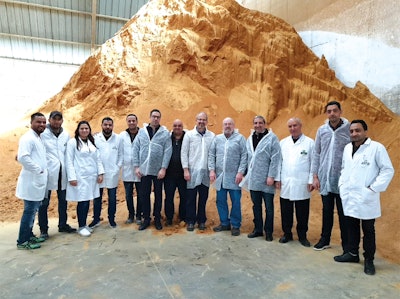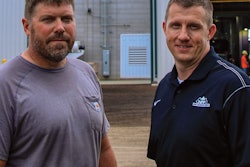
Jan. 23 — the most normal of any day on a calendar. Quite literally, a random Wednesday. One would almost expect it to be boring.
Yet for an unscientific sampling of the U.S. Grains Council’s (USGC’s) staff, it proved to be anything but that. Despite a government shutdown and preparations in high gear for the Council’s annual International Marketing Conference (IMC) – scheduled for Cartagena, Colombia in February – one thing stands out: these folks stay busy.
Manuel Sanchez, regional director for Southeast Asia, Kuala Lumpur, Malaysia
Jan. 23 for many staff members actually starts on Jan. 22; just as farmers in the Midwest are heading to bed, the Council’s offices in Asia are waking up.
Manuel Sanchez has been the director of the Council’s Southeast Asia regional office since 2017. On Jan. 23, he flew to Singapore to meet with his counterpart at the U.S. Soybean Export Council (USSEC) and finalize program plans for the Ag Supply Chain Asia 2019 conference, scheduled for late March in the Philippines. The conference has been held annually for the last 12 years and will this year host more than 200 participants from 130 companies and organizations throughout the value chain.
“This conference aims to provide participants with an in-depth outlook on the current ag markets in the region, so they can better navigate the peaks and troughs,” Manuel says. “While they don’t build demand directly, today’s meetings set the groundwork for us to potentially exceed the sales reported at our last conference together, in Surabaya, Indonesia, which topped 1.5 million tons of U.S. agricultural products at one event.”
Amit Sachdev, South Asia representative for the USGC, New Delhi, India
Amit Sachdev, the Council’s longtime consultant in India, now works throughout South Asia on issues facing grains, distiller’s dried grains with solubles (DDGS) and ethanol. His day-in-the-life notes demonstrated a level of connectivity unfathomable when he started work with the Council more than 20 years ago.
First, a meeting locally with U.S. Department of Agriculture (USDA) officials in New Delhi. USGC and USDA have been working on opening a path for DDGS imports into India. As part of that effort, Amit, members of the Council’s Washington-based staff and USDA officials are working to help plan a team of DDGS end-users that can travel to the United States to see the value chain and get critical information they can share with the government of India. This meeting also included an update on DDGS regulations in other parts of the world.
Next up: calls to two Bangladeshi participants in last fall’s Export Exchange team to explore opportunities for corn gluten meal and DDGS in the aquaculture industry. Then, calls to members of the trade and end-users in Sri Lanka to report on the current price of corn, and a call with USGC’s representative in Pakistan, Shakeb Elahi, to review an assessment of potential activities in 2019 to promote DDGS, sorghum and ethanol.
The day ended with sending out the ethanol price report for the week to contacts in India, Bangladesh and Sri Lanka so they can see emerging trends and make informed decisions on ethanol purchases, especially in India, where imports continue for the industrial sector.
“The work USGC does helps move the needle, making sure people’s lives change for the better and that trade continues,” Sachdev says.
Wayne Bacon, Council representative in the European Union and Black Sea Region
Laying groundwork for future sales was also a part of the work undertaken by Wayne Bacon, a longtime Council consultant who manages issues in Europe and the Middle East/North Africa region.
His key activity on Jan. 23 was working on a DDGS seminar for buyers in Ireland, the United Kingdom and Spain, scheduled for March 2019 if FY2019 Market Access Program (MAP) and Foreign Market Development (FMD) funds are available. Wayne’s time spent planning is an investment in an activity that has significant potential for sales.
As he does daily, Wayne reviewed grain-related news sources for information on the EU and the MENA region, passing on what is relevant to the regional office in Tunis and Washington, D.C. This activity was particularly important while the U.S. government was still closed, and new market reports were not being issued by USDA.
Isaac Belete, information technology manager, Washington, D.C.
Isaac Belete has the unenviable job of keeping the technical systems in the Washington, D.C., office humming, a task that requires a focus on the IT drama of the day and the long-term health of the Council’s networks.
Like every day, he spent part of his time on Jan. 23 helping staff members in the office resolve their computer challenges, so they could remain productive.
Literally the technological backbone of the D.C. headquarters, these activities are meant to equip and protect the Council’s IT infrastructure while balancing budget realities with the every-growing list of staff needs.
“The work I did today is far removed from grain sales, yes, but critical to helping staff stay focused on the USGC vision and mission,” Isaac says.
Kathy Luque, administrative assistant, Panama City, Panama
A member of the Council’s regional office in Panama City, Kathy spent Jan. 23 on the road at the regional nutrition conference in Medellin, Colombia. There, she helped with registration, organized the breaks and meals, oversaw distribution of printed materials, managed audio/visual needs, organized transportation and generally kept the meeting flowing.
“One of the main opportunities we got at this event is to collect feedback,” she says. “I think this is a great opportunity to hear what people thought of the conference and what could be done better in the future. ”
Jorge Lerdo de Tejada and Stephan Wittig, ethanol consultants, Mexico City
Cold January days in Mexico City are characterized by peaks in pollution. The city is in a valley, and its high-altitude mountains stop air flow and contain pollution emitted by the industry, vehicles and natural sources, which then stagnates in a quick-reacting melting pot. Jorge Lerdo de Tejada and Stephan Wittig, ethanol consultants for the Council in Mexico, are personally committed to improving this air quality issue for the good of their country – one reason they do the work they do.
On Jan. 23, they received a last-minute meeting request from a local agency considering the environmental impact of ethanol, part of ongoing energy reforms in Mexico. This meant rearranging the schedule, something they were happy to do.
“Myths persist all around ethanol use. Even lies about cars breaking down or increasing pollution levels have been spread to block ethanol’s mainstream use in Mexico,” Wittig says. “Our daily work focuses on refuting the myths and sharing scientifically-proven, technically-backed information regarding the positive impacts of ethanol. Handling, transportation, storage and blending of ethanol with gasoline all need clarity.”
A technical working group to share the required information will be formed as a follow up to the meeting, including stakeholders focused on environment and energy use. Over time, this work will help demonstrate the potential ethanol holds to help, quite literally, clear the air in Mexico.
Cary Sifferath, senior director of Global Programs, Washington, D.C.
Cary Sifferath, who recently celebrated his 25th anniversary, started his morning like he has most days over those two and a half decades: reading his mail.
Based on an email he saw at 6 a.m., he held an 8 a.m. call with the Southeast Asia office, which he oversees, on a key issue developing in one of those markets.
The issue went on to dominate his day along with the other logistics of directing offices on three continents and across 12 time zones: documentation for a machinery shipment going to Mexico; logistics for a last-minute team from a market suffering drought and looking to import despite strict phytosanitary regulations; providing Asian office staff members direction to be prepared at the upcoming meetings in Cartagena; working with offices under his jurisdiction to deal with administrative and contractual issues made more challenging by the U.S. government shutdown.
“Keeping programs running; keeping great staff and consultants in place; laying groundwork for nearby (next week) and long term (2019 or 2020) are all part of my daily routine,” he says. “Keeping staff motivated in the face of trade issues and funding uncertainty is also part of daily routine.” ■

















